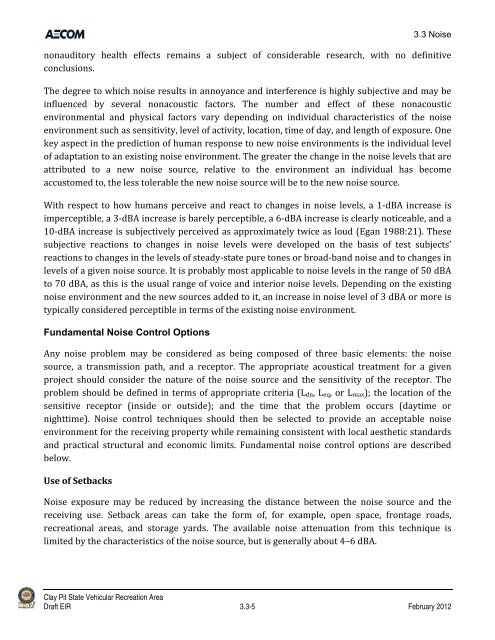Draft Environmental Impact Report - California Off Highway Vehicle ...
Draft Environmental Impact Report - California Off Highway Vehicle ...
Draft Environmental Impact Report - California Off Highway Vehicle ...
You also want an ePaper? Increase the reach of your titles
YUMPU automatically turns print PDFs into web optimized ePapers that Google loves.
3.3 Noise<br />
nonauditory health effects remains a subject of considerable research, with no definitive<br />
conclusions.<br />
The degree to which noise results in annoyance and interference is highly subjective and may be<br />
influenced by several nonacoustic factors. The number and effect of these nonacoustic<br />
environmental and physical factors vary depending on individual characteristics of the noise<br />
environment such as sensitivity, level of activity, location, time of day, and length of exposure. One<br />
key aspect in the prediction of human response to new noise environments is the individual level<br />
of adaptation to an existing noise environment. The greater the change in the noise levels that are<br />
attributed to a new noise source, relative to the environment an individual has become<br />
accustomed to, the less tolerable the new noise source will be to the new noise source.<br />
With respect to how humans perceive and react to changes in noise levels, a 1‐dBA increase is<br />
imperceptible, a 3‐dBA increase is barely perceptible, a 6‐dBA increase is clearly noticeable, and a<br />
10‐dBA increase is subjectively perceived as approximately twice as loud (Egan 1988:21). These<br />
subjective reactions to changes in noise levels were developed on the basis of test subjects’<br />
reactions to changes in the levels of steady‐state pure tones or broad‐band noise and to changes in<br />
levels of a given noise source. It is probably most applicable to noise levels in the range of 50 dBA<br />
to 70 dBA, as this is the usual range of voice and interior noise levels. Depending on the existing<br />
noise environment and the new sources added to it, an increase in noise level of 3 dBA or more is<br />
typically considered perceptible in terms of the existing noise environment.<br />
Fundamental Noise Control Options<br />
Any noise problem may be considered as being composed of three basic elements: the noise<br />
source, a transmission path, and a receptor. The appropriate acoustical treatment for a given<br />
project should consider the nature of the noise source and the sensitivity of the receptor. The<br />
problem should be defined in terms of appropriate criteria (Ldn, Leq, or Lmax); the location of the<br />
sensitive receptor (inside or outside); and the time that the problem occurs (daytime or<br />
nighttime). Noise control techniques should then be selected to provide an acceptable noise<br />
environment for the receiving property while remaining consistent with local aesthetic standards<br />
and practical structural and economic limits. Fundamental noise control options are described<br />
below.<br />
Use of Setbacks<br />
Noise exposure may be reduced by increasing the distance between the noise source and the<br />
receiving use. Setback areas can take the form of, for example, open space, frontage roads,<br />
recreational areas, and storage yards. The available noise attenuation from this technique is<br />
limited by the characteristics of the noise source, but is generally about 4–6 dBA.<br />
Clay Pit State Vehicular Recreation Area<br />
<strong>Draft</strong> EIR 3.3-5 February 2012








